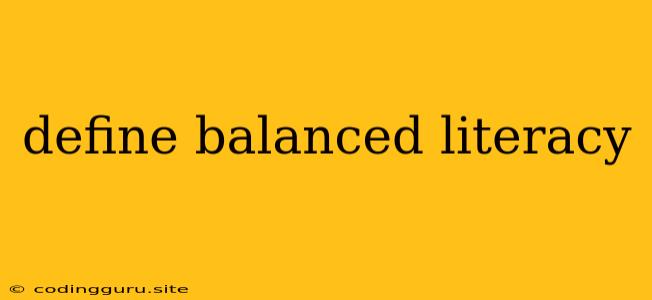What is Balanced Literacy?
Balanced literacy is a comprehensive approach to reading instruction that emphasizes a balanced use of various instructional methods. It seeks to empower students with a strong foundation in literacy skills through reading, writing, speaking, and listening. This approach recognizes that literacy is not a singular skill but rather a complex tapestry of interconnected abilities.
Balanced literacy is not a specific curriculum or program. Rather, it is a framework that encourages teachers to implement a variety of strategies and approaches in their classrooms. This framework helps students develop a deep understanding of language and how it works.
Why is Balanced Literacy Important?
Balanced literacy is essential for:
- Engaging all learners: By offering a diverse range of instructional methods, balanced literacy caters to the unique needs and learning styles of every student.
- Developing well-rounded readers: This approach helps students become not just proficient decoders but also critical thinkers and active participants in the reading process.
- Building a strong foundation in language: Balanced literacy promotes a deep understanding of language, allowing students to confidently engage in reading, writing, speaking, and listening.
- Encouraging a love of reading: Balanced literacy fosters a positive and engaging learning environment where students can develop a genuine love for reading.
Key Components of Balanced Literacy
Balanced literacy is built on a foundation of several key components, each contributing to the holistic development of literacy skills:
1. Explicit Instruction:
This refers to direct, systematic teaching of foundational reading skills like phonics, phonemic awareness, and fluency. Students learn these essential skills through structured lessons and practice activities.
2. Guided Reading:
Guided reading involves small-group sessions where teachers provide support and guidance as students read text at their independent reading level. This is a highly interactive approach that encourages active engagement and builds confidence.
3. Independent Reading:
Students are given ample time and opportunity to engage with text independently. They can choose books at their own reading level and enjoy the freedom to explore different genres and authors.
4. Writing Workshop:
Writing workshop is a structured approach to writing instruction that encourages students to experiment with different writing forms, explore their own voice, and develop their writing skills.
5. Word Work:
This component focuses on developing students' vocabulary and spelling skills. It includes activities like word sorts, word building, and etymology explorations.
6. Listening and Speaking:
Balanced literacy recognizes the importance of listening and speaking skills. Students are actively engaged in discussions, sharing their ideas, and participating in oral language activities.
Tips for Implementing Balanced Literacy in the Classroom
1. Understand your students: Assessing their individual needs and learning styles is crucial for tailoring instruction to their specific strengths and areas for growth.
2. Foster a love of reading: Create a welcoming and stimulating classroom environment where students are excited to engage with books and explore different genres.
3. Provide a variety of instructional materials: Incorporate diverse books, graphic novels, audiobooks, and multimedia resources to appeal to different interests and learning styles.
4. Use technology effectively: Technology can be a valuable tool for supplementing instruction and providing personalized learning opportunities.
5. Collaborate with other teachers: Sharing strategies and best practices can help you implement balanced literacy effectively and continuously improve your instructional approaches.
Examples of Balanced Literacy in Action
1. During a reading lesson:
- The teacher might begin with explicit instruction on a new phonics skill.
- Next, they might engage in guided reading with a small group of students.
- Finally, students would have independent reading time where they can choose books from a classroom library.
2. During a writing workshop:
- Students might start by brainstorming ideas for a narrative writing assignment.
- The teacher would then provide structured lessons on specific writing strategies, like character development or plot structure.
- Finally, students would have time to work independently on their writing projects, with the teacher providing individual feedback and support.
Conclusion
Balanced literacy is a powerful approach to teaching literacy that recognizes the importance of providing a diverse and engaging learning experience. By implementing its key components, teachers can empower students to become confident and capable readers, writers, speakers, and listeners.
